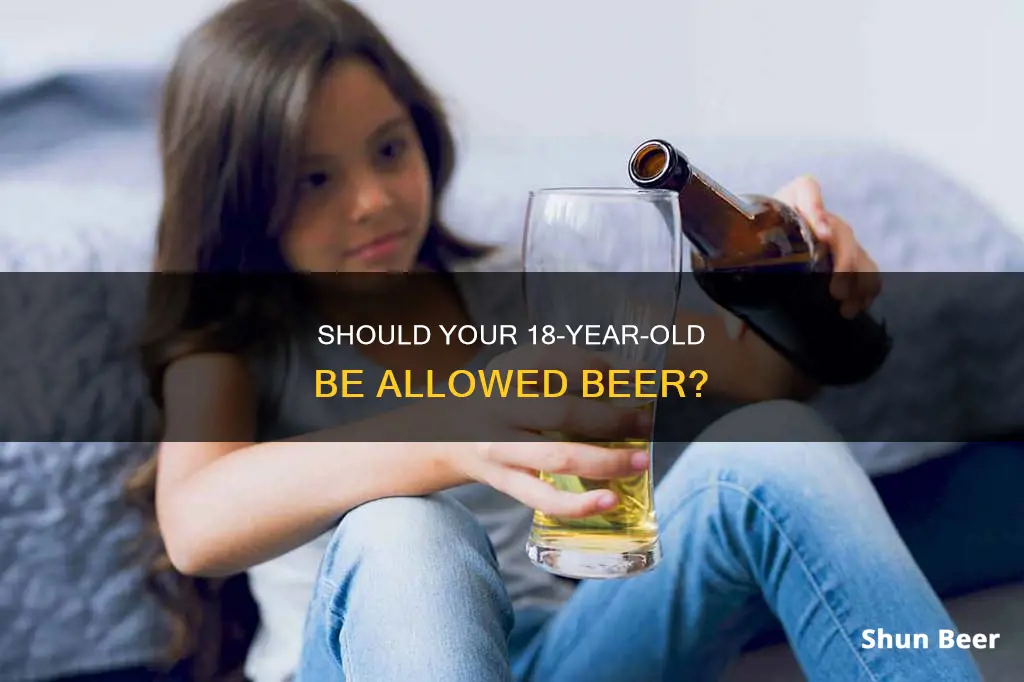
In the United States, the legal drinking age is 21 years old, and the same goes for buying non-alcoholic beer, which is still regulated by the Federal Alcohol Administration Act. However, in some states, minors are allowed to consume alcohol under the supervision of a parent, guardian, or spouse above 21 years old. While it is ideal for teens not to drink alcohol, it may not always be realistic, and parents often feel pressured to supply alcohol to their teens if their peers are doing the same. Studies have shown that not providing adolescents with alcohol is the best way to prevent binge drinking, alcohol-related harm, and problem drinking in early adulthood. However, if parents do provide alcohol, giving sips under supervision and delaying supplying whole drinks for as long as possible is recommended to minimize harm.
What You'll Learn

Alcohol is a leading cause of death and illness in young people
Alcohol is a psychoactive and toxic substance that can cause dependence. It is one of the leading preventable causes of death and illness in young people, with 2.6 million deaths worldwide attributed to alcohol consumption in 2019. This figure includes deaths from noncommunicable diseases, injuries, and communicable diseases. The highest levels of alcohol-related deaths per 100,000 persons are observed in the WHO European and African Regions, with 52.9 and 52.2 deaths respectively.
Young people are particularly vulnerable to the negative effects of alcohol consumption, with the highest proportion (13%) of alcohol-attributable deaths in 2019 occurring among those aged 20-39. Alcohol consumption is a causal factor in more than 200 diseases, injuries, and other health conditions. These include liver disease, heart disease, and different types of cancer. It is also linked to mental health and behavioural conditions such as depression, anxiety, and alcohol use disorders.
Alcohol misuse is the seventh-leading risk factor for premature death and disability globally. It is estimated that approximately 28.9 million people in the United States had an alcohol use disorder (AUD) in 2023. Alcohol consumption during pregnancy can also cause fetal alcohol spectrum disorders (FASDs) and increase the risk of pre-term birth complications, including miscarriage, stillbirth, and premature delivery.
In addition to the direct health impacts, alcohol consumption can lead to social problems for young people, including family issues, problems at work, financial difficulties, and unemployment. It is important for young people to be aware of the risks associated with alcohol consumption and to take individual actions to protect themselves from its harmful effects. There are effective alcohol control interventions available, and it is crucial to utilise these to reduce the burden of alcohol-related illness and death in young people.
Drinking Alcohol-Free Beer at Work: Is It Okay?
You may want to see also

Non-alcoholic beer is a viable alternative
Health Benefits
Non-alcoholic beer has several health benefits that make it a better choice than alcoholic beer. Firstly, it is a good source of essential vitamins, minerals, fiber, and antioxidants, including B vitamins, calcium, potassium, zinc, selenium, and iron. It also contains high amounts of silicon, which is important for bone health and can help reduce the risk of osteoporosis. In addition, the polyphenols in non-alcoholic beer can improve cardiovascular health by reducing blood pressure, inflammation, and homocysteine levels.
Rehydration
Non-alcoholic beer is also a good option for rehydration after exercise. Unlike alcoholic beer, it does not have a diuretic effect and can help maintain fluid balance. Studies have shown that non-alcoholic beer is better able to rehydrate the body than alcoholic beer, as it does not increase urine output or affect blood volume levels after exercise.
Sleep and Stress
The hops in non-alcoholic beer, which give the beverage its distinct flavor, also have a sedative effect and can improve sleep patterns. Studies have shown that drinking non-alcoholic beer in the evening can help people fall asleep faster and improve overall sleep quality. Additionally, non-alcoholic beer has been found to reduce feelings of anxiety and stress in experimental studies.
Social Alternative
Non-alcoholic beer can be a great alternative for 18-year-olds who want to socialize without consuming alcohol. It allows them to enjoy the taste of beer and the social aspect of drinking without the negative consequences of alcohol consumption.
In conclusion, non-alcoholic beer is a viable and healthier alternative to alcoholic beer for 18-year-olds. It offers many of the same benefits as alcoholic beer, such as improved cardiovascular health and rehydration, while also promoting better sleep and reduced stress. It is a good option for those who want to avoid the negative side effects of alcohol while still enjoying a beer-drinking experience.
Kayaking and Beer: Texas Rules and Regulations
You may want to see also

Parental influence is key to a teen's drinking habits
Parents can help their children develop healthy attitudes towards drinking while minimising the risks. Authoritative parents, who provide a healthy and consistent balance of discipline and support, are the most likely to have teenagers who respect the boundaries they have established around drinking. Research has shown that 80% of teens feel that parents should have a say in whether they drink alcohol.
It is important for parents to set the right example and have open and frank conversations with their children about their expectations. Parents should explain the importance of drinking moderately and why only adults should consume alcohol. Parents should also be aware of their state's laws about providing alcohol to their children.
It is also important for parents to talk early and often with their children about alcohol, in developmentally appropriate ways. Adolescents who know their parents' opinions about youth drinking are more likely to fall in line with their expectations. Establishing policies early on and being consistent in setting expectations and enforcing rules are also key.
Parents can also work with other parents to monitor their children's activities and promote dialogue about underage drinking and the creation and implementation of action steps to address it.
Beer for Breakfast: An Exploration of Morning Drinking Culture
You may want to see also

Drinking in adolescence can lead to physical and mental health issues
Adolescence is a critical period of physical and emotional growth. Drinking during this time can cause real harm to the developing brain, body, and mental health, with serious and even deadly consequences. Alcohol affects young people more powerfully than adults, and drinking before the brain and body are fully developed can have dangerous effects.
Brain Development
Underage drinking can change the way the brain develops and functions. Alcohol can shut down new brain cell growth and damage the parts of the brain responsible for learning, memory, and self-control. Research has shown that drinking alcohol during adolescence affects brain functioning and development. Youth with alcohol use disorders had significantly smaller left and right hippocampi, which are critical for the formation of new memories. These results suggest that, during adolescence, the hippocampus may be particularly vulnerable to the adverse effects of alcohol.
Physical Health
High levels of alcohol in the body can shut down the parts of the brain that control breathing, heart rate, and body temperature. Heavy alcohol use can increase the risk of liver disease and heart disease. It can also increase the risk of seven different cancers later in life. Youth who drink heavily are more likely to experience alcohol poisoning, as they usually drink more than an adult would when they have access to alcohol.
Mental Health
Underage drinking is associated with higher rates of depression, anxiety, and suicide. As young people transition from childhood to adolescence, they experience dramatic social and emotional changes. Adding alcohol to the mix can be devastating. Suicide is the third leading cause of death among those aged 15-29.
Behavioural Consequences
Underage drinking is associated with a higher risk of physical and sexual assault. Youth with alcohol use disorders are twice as likely to have a sexually transmitted disease, and girls with alcohol problems are three times more likely to have a pregnancy before age 18. Alcohol reduces students' ability to think clearly and is associated with poor attendance, truancy, and school drop-out. Youth with alcohol problems are also more likely to run away from home and experience family conflict.
Mixing Milk and Beer: A Safe Drinking Combination?
You may want to see also

Alcohol supply and access should be limited
While the legal drinking age in the US is 21, teenagers still have easy access to alcohol. A 2005 American Medical Association (AMA) survey of teens aged 13 to 18 found that two out of three teens can get alcohol from their homes without their parents knowing, and two out of five teens say that it is easy to get alcohol from a friend's parents. Underage drinkers who pay for alcohol usually give money to someone else to buy it for them.
- Lock up alcohol at home: Ensure that alcohol is not easily accessible to teens. Keep it locked up in a cabinet or another secure place.
- Communicate your expectations: Talk to your teens about your expectations regarding alcohol consumption. Let them know that you do not want them to drink and that most teens do not drink. It is important to have open and honest conversations about the risks and dangers of underage drinking.
- Teach them how to say no: Give your teens the tools they need to resist peer pressure. The National Institute on Alcohol Abuse and Alcoholism suggests responses such as "I don't feel like it" or "Alcohol's not my thing".
- Speak to other adults: Talk to the parents of your teen's friends, teachers, coaches, and local retailers. Let them know that you do not want them to provide alcohol to your teen or condone underage drinking.
- Monitor parties and gatherings: If you are hosting a party or gathering where alcohol is served, make sure to keep track of how much alcohol is being consumed and by whom. Do not allow teens to drink without supervision.
- Educate teens about the risks: Teach teens about the dangers of underage drinking, including the increased risk of alcoholism, the negative impact on brain and body development, and the heightened risk of accidents, especially while driving.
- Set a good example: As a parent or guardian, be mindful of the example you set for teens. Moderate alcohol consumption may be considered acceptable in adult social circles, but it can send the wrong message to teens.
- Enforce laws and policies: Support and advocate for strict enforcement of laws and policies that prohibit the sale of alcohol to minors. This includes commercial outlets, such as stores and restaurants, as well as social hosts.
Beer and Hunting: What's the Legal Limit?
You may want to see also
Frequently asked questions
It depends on where you live. In the United States, for example, the drinking age is 21. However, in some states, 18-20-year-olds are allowed to drink beer with parental permission or in the presence of a parent or guardian.
While it may be legal in some places for 18-year-olds to drink beer, it is generally not considered safe for teens to consume alcohol. Alcohol is one of the biggest contributors to death and illness in young people, and not offering your teen alcohol is the best way to prevent later binge drinking and alcohol-related harms.
If you are looking for non-alcoholic alternatives to beer, there are many options available, including non-alcoholic beer, juice, soda, and water.







